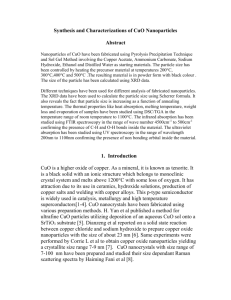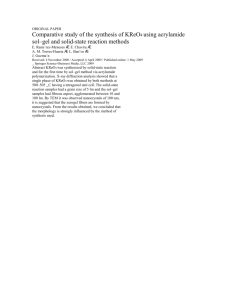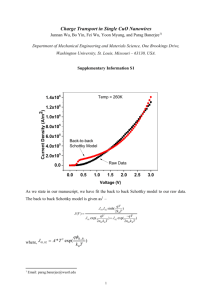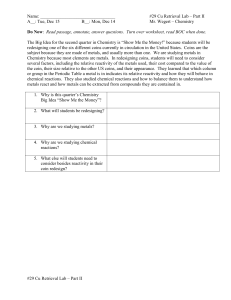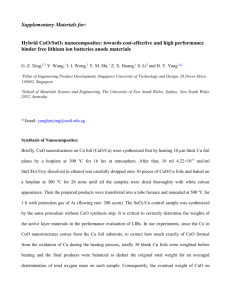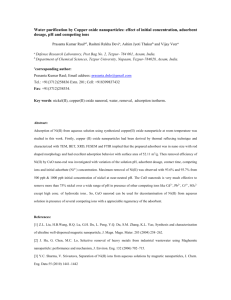1.3 Characterizations
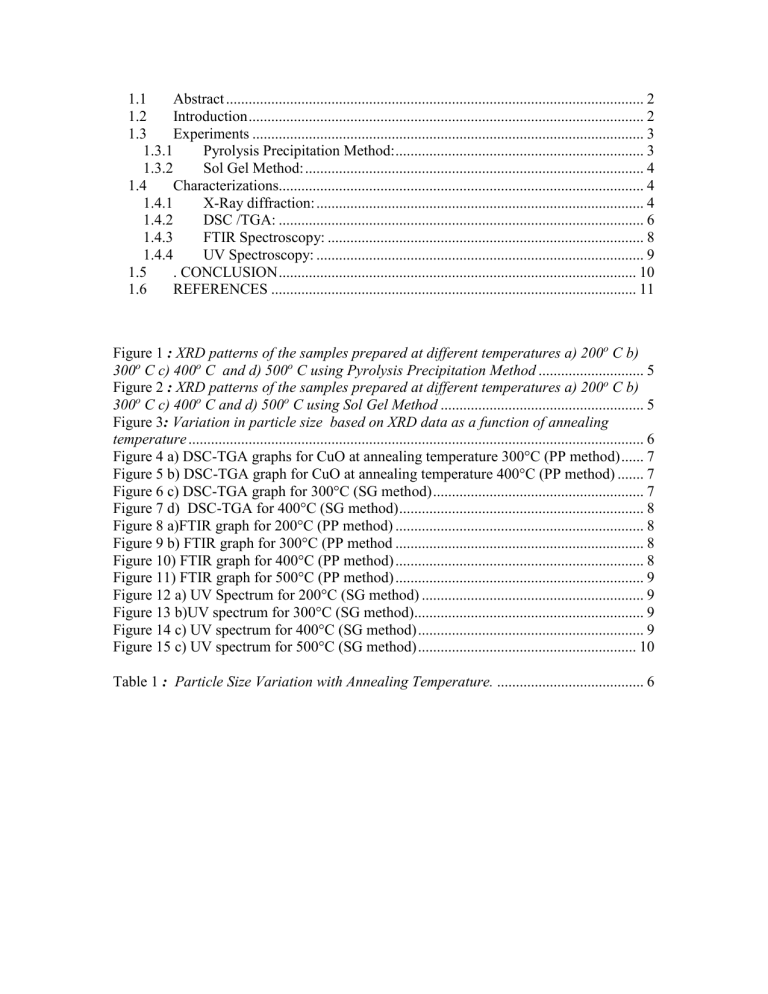
Figure 1 : XRD patterns of the samples prepared at different temperatures a) 200 o
Figure 2 : XRD patterns of the samples prepared at different temperatures a) 200 o
C using Sol Gel Method ...................................................... 5
Figure 4 a) DSC-TGA graphs for CuO at annealing temperature 300°C (PP method) ...... 7
Figure 5 b) DSC-TGA graph for CuO at annealing temperature 400°C (PP method) ....... 7
Table 1 : Particle Size Variation with Annealing Temperature.
....................................... 6
MS.NO. 7925-SA
Ref-Marked Copy
Synthesis and Characterizations of Copper Oxide Nanoparticles
1.1
Abstract
Nanoparticles of CuO have been fabricated using Pyrolysis Precipitation
Technique and Sol Gel Method involving the Copper Acetate,
Ammonium Carbonate, Sodium Hydroxide, Ethanol and Distilled Water as starting materials. The particle size has been controlled by heating the precursor material at temperatures 200°C, 300°C, 400°C and 500°C .The resulting material is in powder form with black colour. The size of the particle has been calculated using XRD data.
The XRD data have been used to calculate the particle size using
Scherrer formula. It also reveals the fact that particle size is increasing as a function of annealing temperature. The thermal properties have been studied using DSC/TGA in the temperature range of room temperature to
1100°C. The infrared absorption has been studied using FTIR spectroscopy confirming the presence of C-H and O-H bonds inside the material. The ultraviolet absorption has been studied using UV spectroscopy confirming the presence of non bonding orbital inside the material.
1.2
Introduction
CuO is a higher oxide of copper. As a mineral, it is known as tenorite. It is a black solid with an ionic structure which belongs to monoclinic crystal system and melts above 1200°C with some loss of oxygen. It has attraction due to its use in ceramics, hydroxide solutions, production of copper salts and welding with copper alloys. This p-type semiconductor is widely used in catalysis, metallurgy and high temperature super conductor [1-4]. CuO nanocrystals have been fabricated using various preparation methods. H. Yan et al [5] published a method for ultrafine
CuO particles (size range will be beneficial) utilizing deposition of an aqueous CuO solution or solvent???- ) on to a SrTiO
3
substrate. Dianzeng
et al [6] reported solid state reaction between copper chloride and sodium hydroxide to prepare copper oxide nanoparticles with the size of about 23 nm. Same experiments were performed by Corrie L et al [7] to obtain copper oxide nanoparticles yielding a crystallite size range 7-9 nm.
Haiming Fani et al [8] synthesized CuO nanocrystals with size range of
7-100 nm and studied their size dependant Raman scattering spectra .
Recently, Borgohain et al [9] reported the quantum size effect in CuO nanocrystals . Controlled synthesis of mono dispersed CuO nanocrystals was carried out by Fan et al [10] using pyrolysis precipitation technique.
This is a chemical process in which chemical precursors decompose under suitable thermal treatment into one solid compound and unwanted waste evaporates away. Fani et al [8] synthesized monodispersed spherical CuO nanocrystals with a high purity 99.99 % .
This paper describes the synthesis of CuO nanoparticles using wet chemistry involving pyrolysis precipitation method and sol gel method. It has been seen in both synthetic methodologies that the size of nanoparticles can be controlled by varying the annealing temperature, solution composition, starting material, concentration and heating time.
Pyrolysis Precipitation method is based on selecting a suitable precursor from different chemical reactions to produce required nanocrystals. For this purpose precursors are synthesized first and then the correct one is chosen which generates CuO nanocrytals. Sol gel is another method used widely to prepare thin film coatings. It is a four step process consisting of hydrolysis, polycondensation, drying and thermal decomposition.
1.3
Experiments
1.3.1
Pyrolysis Precipitation Method:
50 ml of aqueous ammonium carbonate is added rapidly to 300 ml aqueous copper acetate. This solution is mixed and put in centrifuge and washed with distilled water and absolute ethanol to separate precipitates.
Then precipitates are placed in crucibles and dried well at temperature
60°C. This resulting powder is thermally decomposed in a furnace at temperatures 200°C, 300°, 400°C and 500° to obtain CuO nanoparticles.
1.3.2
Sol Gel Method:
1.5 gm of copper chloride was dissolved with 70ml of absolute ethanol.
0.9gm of sodium hydroxide was dissolved with 20ml of absolute ethanol.
Both solutions are mixed drop wise and stirred well to form copper hydroxide and sodium chloride gel. This gel is filtered to remove aqueous sodium chloride and then centrifuged and washed with distilled water and absolute ethanol to remove sodium chloride contents. The resulting copper hydroxide is thermally decomposed in a furnace at temperatures
200°C, 300°, 400°C and 500° to obtain CuO nanoparticles.
1.4
Characterizations
The size of size of crystallites was determined by using Scherrer formula
DSC/TGA was used to study the thermal properties of materials UV&
FTIR spectroscopy was used to determined the stretching and bending of bonds for optical behaviors.
1.4.1
X-Ray diffraction :
From XRD data, we obtained diffraction patterns that showed that CuO nanoparticles are crystallites and peaks becomes sharper as the annealing temperature has been increased it is because of particle size broadening at higher temperatures. This broadness of peaks has been used to calculate the particle size of crystallites using Scherrer formula. The variation in particle size as a function of annealing temperature has been presented in figures 1 and 2 using pyrolysis precipitation technique and sol gel technique respectively.
A graph between annealing temperature and particle size have been plotted in figure 3, which shows that particle size is increasing with the increase in the annealing temperature almost linearly 300°C to onwards, which is the strength of our fabrication techniques to control the particle size of the fabricated nanocrystalline materials in this laboratory. It has also been investigated that there is a large particle size distribution for sol gel method as compared to precipitation method.
To check the grain size of different samples annealed at different temperatures and make comparison between different results obtained from these techniques an intensive study is carried out.
●CuO
Figure 1 : XRD patterns of the samples prepared at different temperatures a) 200 o C b)
300 o
C c) 400 o
C and d) 500 o
C using Pyrolysis Precipitation Method
●CuO
Figure 2 : XRD patterns of the samples prepared at different temperatures a) 200 o
C b)
300 o C c) 400 o C and d) 500 o C using Sol Gel Method
Particle Size (nm) Annealing
Temperature ( °C)
(PP Method)
200
300
400
11.1
11.3
13.7
Annealing
Temperature ( °C)
(SG Method)
200
300
400
500 17.8 500
Table 1 : Particle Size Variation with Annealing Temperature.
Particle Size (nm)
11.1
11.4
14.4
19.6
Figure 3 : Variation in particle size based on XRD data as a function of annealing temperature
1.4.2
DSC /TGA:
Simultaneous DSC-TGA curves show that heat is absorbed by the samples in a specific heat range. That heat absorbed is due to phase transition in samples and weight loss by the samples. Because whenever heat is absorbed by the sample, some material is evaporated and this results in weight loss of the sample. But when the temperature of the sample is not increasing (no heat absorption) and there is a weight loss,
then this loss is not of actual sample but that must be of some existing impurities which lose with the passage of heat.
Another important point which has been investigated is that melting temperature of nanoparticles is less than their bulk material. The melting point of CuO bulk material is 1201°C but the nanoparticles prepared by us have melting point less than 1100°C. It is because of quantum size effect of nanomaterials.
Another noticeable point is that the samples prepared at high annealing temperatures have high melting point temperatures because as we go on increasing the annealing temperature, the material starts to become bulk.
Figure 4
a) DSC-TGA graphs for CuO at annealing temperature 300°C (PP method )
Figure 5 b) DSC-TGA graph for CuO at annealing temperature 400°C (PP method)
Figure 6
c) DSC-TGA graph for 300°C (SG method)
Figure 7
d) DSC-TGA for 400°C (SG method)
1.4.3
FTIR Spectroscopy:
FTIR was used for optical study of copper oxide powder. The annealed samples were ground with KBr and pressed into pellets. IR spectra were taken after heat treatment at 200,300,400 and 500 o C. A gradual loss of
O-H stretching ,C-H stretching, O-H bending and C-H bending was also observed.
Figure 8
a)FTIR graph for 200°C (PP method)
Figure 9
b) FTIR graph for 300°C (PP method
)
Figure 10
) FTIR graph for 400°C (PP method)
Figure 11
) FTIR graph for 500°C (PP method)
1.4.4
UV Spectroscopy:
UV – Visible absorption spectra of different sized CuO nanoparticles have also been studied for finding the optical structure of material. This analysis shows the clear evidenence of non orbital bonding inside the
CuO material which confirms the P-Type semiconductor behavior of
CuO.
Figure 12
a) UV Spectrum for 200°C (SG method)
Figure 13 b)UV spectrum for 300°C (SG method)
Figure 14
c) UV spectrum for 400°C (SG method)
Figure 15
c) UV spectrum for 500°C (SG method)
1.5
. CONCLUSION
Crystal structure, thermal properties and absorption studies of CuO nanoparticles have been investigated. The formation of semiconductor nanocrystals has been confirmed by the X-ray diffraction. It has been observed that CuO nanocrystals show quantum size effect because of small surface area to volume ratio. It has been observed that different annealing temperatures has an impact on the physical properties of nanocrystals. The size of naoparticles can be controlled by controlling their composition parameters, starting material and annealing temperatures. It has also been investigated that Pyrolysis Precipitation Technique is advantageous as compared to Sol Gel Technique because there is less noise in XRD results due to impurities in pyrolysis precipitation method but in Sol Gel Technique, it is difficult to form gel and also presence of water and sodium chloride contents have caused noise in XRD results. The major shortfall that comes out in this research is that less noise has been observed in pyrolysis precipitation technique than sol gel method. It has also been observed in this research that as we go on increasing the annealing temperature of particles, we get a bulk copper oxide material again.
1.6
REFERENCES
[1].
Larsson, P Andersson, A,J catal 1998, 179,72
[2].
Chikan, V Monhar, A Balazsik,, K J Catal 1999, 184,134
[3].
Raveau B Michel C, Herview, M Groult, D. Crystal Chemistry of High –Tc superconducting Copper Oxides, Springer-Verlag. Berlin 1991.
[4].
Poole, C P Datta, T Farach, H.A Rigney ,M.M Sanders, C R .Copper Oxide
Superconductors, John Wiley & Sons: New York,1988
[5].
Hai Yan, D; Yu-Ling, Z; Jing Kui, L; SI-Shen, X.J.Mater.Sci 1993,28,5176-5178.
[6].
Dainzeng, J; Jianqun, Y;Xi, X. Chin.Sci,Bull.1998,43,7,571-573
[7].
Corrie L. Carnes, Jennifer Stipp, and Keneth J. Klabunde, Department of
Chemistry, Kansas State University, Manhattan, Kansas. John Bonevich, National
Institute of Standards and Technology, Metallurgy, Gaitherburg, Maryland,
Received May 10, 2001
[8].
Haiming Fani, Bingsuo Zoul, Yulong Liu and Sishen Xie Changsha 410082;
Beijing 10080,P.R China
[9].
Borgohain K, Singh JB, Rama Rao MV, Shripathi T and Mahamuni S 2000 Phys
Rev B 61 11093
[10].Haiman Fan, Lintao Yang, Wenshen Hua, Xingfang Wu, , Zhenyu Wu, Sishen
Xie and Binguo Zou ,NanoPhysics and Nanodevice Laboratory, Institute of Physics,
Chinese Academy of Sciences, Beijing, People’s Republic of China, Department of
Materials Physics, University of Sciences and Technology Beijing, People’s Republic of China. Received 24 March 2003. Online at stacks.iop.org/Nano
